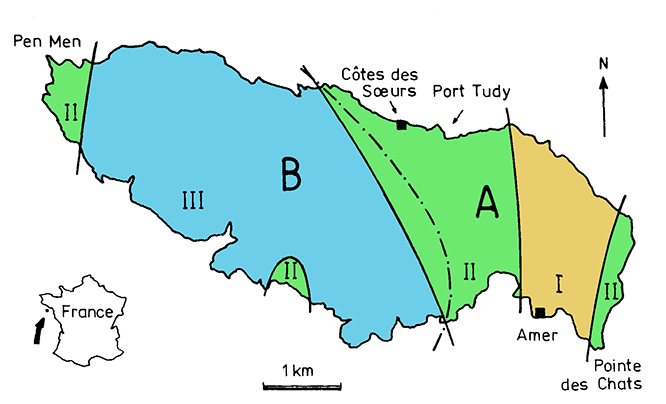Blueschist, Ile de Groix
Ile de Groix, situated about 10 km from the south coast of Brittany (Fig.1), represents the emerged part of NW-SE elongated metamorphic belt. This belt, covering an area of about 40 x 10 km, consists of rocks formed under high-pressure and low- or medium-temperature conditions (blueschist and eclogite facies). Geochronological investigations indicate that high-pressure metamorphism took place around 420-400Ma ago. Ile de Groix and Bois de Cené (Vendée, some 150-200 km SE) provide the only evidence for this type of metamorphism in the entire Variscan fold-belt of Western Europe.Two main phases of deformation were described according to the metamorphic history (Quinquis, 1980; Quinquis & Choukroune, 1981). The first event (D1) corresponds to the progressive deformation responsible for the blueschist facies foliation S1. It started during the prograde path and the HP-LT event (M1), and lasted up to the beginning of the retrograde metamorphism (M2). The second phase of deformation (D2) coincided with the greenschist facies retrograde metamorphism and was responsible for the deformation of S1 and for the formation of the large scale antiform and the crenulation cleavage S2. Eclogites and blueschist facies rocks are frequent in the eastern part of the island, whereas greenschist facies rocks are dominant in the western part.

Fig.1: Geological setting of the Ile de Groix in the frame of the Hercynian belt of southern Brittany. a) Simplified geological map of the metamorphic domain of southern Brittany with the location of the Ile de Groix. SASZ = South Armorican Shear Zone. b) Cross section AB (see location in a) showing the structural position of the Ile de Groix blueschists (modified after Philippon, M., 2009).
The Ile de Groix corresponds to the emerged part of an HP-LT metamorphic Hercynian blueschist-eclogite unit. It is interpreted as the remnant of a Paleozoic accretionary complex formed after subduction and exhumation of oceanic crust and its sedimentary cover (Bernard-Griffiths et al., 1986; El Korh et al., 2009). The HP-LT metamorphic rocks consist of about 20% metabasite lithologies, varying from a few centimeters to meter-scale lenses to layers of several tens of meters, intercalated with 80% metapelites. The P-T conditions (Fig.2-3) and the subdivision of the prograde metamorphic sequence are still controversial. On the basis of metabasic assemblages, Triboulet (1974) distinguished three zones (Fig.2):
I = eclogite facies zone (8.5 kbar, 530°C);
II = glaucophane-epidote-garnet facies zone (8kbar, 500°C);
III = greenschist facies zone (7.5kbar, 470°C);
Carpenter (1976) recognized two contrasting areas (Fig.2):
A ( P = 8 +/- 1.5 kbar, T = 400 +/- 50 °C) and B (P = 6.5-8 kbar, T < 400 °C).
The principal difference between these two areas is a lack of garnets in the metabasites of zone B. According to Quinquis (1980), Carpenter's isograd of garnet in metabasic rocks has a structural significance as well; the higher-grade zone A (eastern part of the island) seems to lie above the lower-grade zone B.

Fig.2: Sketch-map of Ile de Groix. I, II, III = metamorphic zones according to Triboulet (1974) (separated by solid line). A and B = metamorphic zones according to Carpenter (1976) and Quinquis (1980) (dash-dotted line). Modified after Dudek, K. (1989).

Fig.3: Metamorphic map of the Ile de Groix showing the location of the garnet isograd and the occurrence of lawsonite pseudomorphs. The lithological contours are only shown along the seashore. The PT paths for the western and eastern part of the island are shown in the insert (after Bosse et al., 2002). From Philippon, M., (2009).
The most common rocks of Ile de Groix series are mica schists. Intercalated with these are metabasic rocks, chiefly greenschists, amphibolites, blueschists and eclogites. The thickness of the metabasic intercalations varies from a few centimetres to several tens of metres.
Among the metabasic rocks of the eastern part of Ile de Groix (zone A according Carpenter and Quinquis) garnet glaucophanites (assemblage: glaucophane-garnet-pyroxene-epidote) and amphibolites (glaucophane-blue-green amphibole-epidote-garnet) are the most common. Scarce outcrops of eclogites, abundant in jadeitic pyroxenes, have been reported as well. Metapelites of this zone are represented by heterogeneous, quartzo-phengitic mica schists with chloritoid, chloritoid + garnet, or chloritoid + garnet + glaucophane. All these assemblages can contain such accessory minerals as quartz, phengite, chloritoid (metabasites), epidote, albite, tourmaline (mica schists) and biotite, stilpnomelane, apatite, sphene, rutile, and opaques (both groups of rocks).
West of the garnet isograd, the metabasites of zone B are represented by greenschists, amphibolites and prasinites. Except for lack of garnet, the abundance of the blue-green amphibole barroisite (more abundant than glaucophane) is of major importance. The typical assemblages are: (1) blue-green amphibole-glaucophane-epidote-chlorite and (2) albite-epidote-chloriteblue-green amphibole. The most common assemblage in the mica schist of this zone is: quartz-phengite-chloritoid-stilpnomelane-chlorite.
.jpg)
Blueschist from Ile de Groix. Blue = glaucophane. From Wikipedia.
.jpg)
Blueschist from Ile de Groix. Blue = glaucophane, red = garnet. From Planet-terre.
.jpg)
Blueschist from Ile de Groix. Blue = glaucophane, red = garnet. From Planet-terre.
Sample done by Justine FrancommeBibliography
• Philippon, M., Brun, J. P., & Gueydan, F. (2009). Kinematic records of subduction and exhumation in the Ile de Groix blueschists (Hercynian belt; Western France). Journal of Structural Geology, 31(11), 1308-1321.
• Dudek, K. (1989). Deerite from Ile de Groix, Brittany, France. Mineralogical Magazine, 53, 603-612.


.jpg)
.jpg)
.jpg)
.jpg)
.jpg)
.jpg)
.jpg)
.jpg)
.jpg)
.jpg)
.jpg)
.jpg)
.jpg)
.jpg)
.jpg)
.jpg)
.jpg)
.jpg)
.jpg)
.jpg)
.jpg)
.jpg)
.jpg)